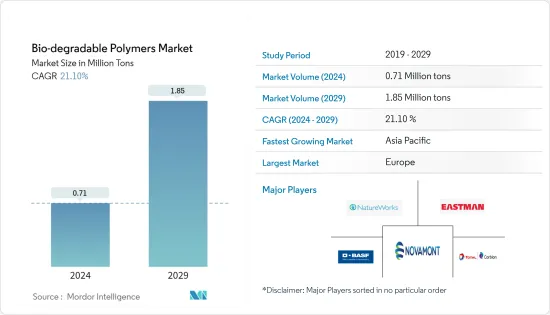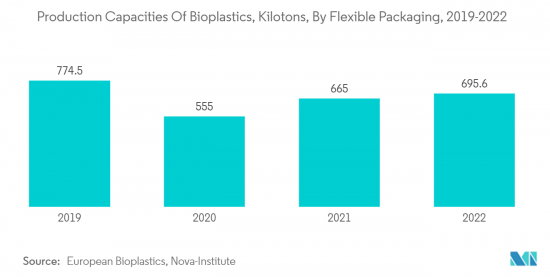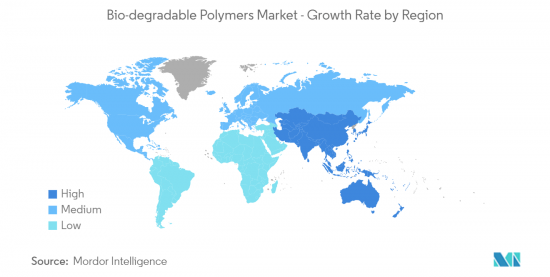 |
市場調査レポート
商品コード
1429479
生分解性ポリマー:市場シェア分析、産業動向、成長予測(2024~2029年)Bio-degradable Polymers - Market Share Analysis, Industry Trends & Statistics, Growth Forecasts (2024 - 2029) |
||||||
● お客様のご希望に応じて、既存データの加工や未掲載情報(例:国別セグメント)の追加などの対応が可能です。 詳細はお問い合わせください。
| 生分解性ポリマー:市場シェア分析、産業動向、成長予測(2024~2029年) |
|
出版日: 2024年02月15日
発行: Mordor Intelligence
ページ情報: 英文 120 Pages
納期: 2~3営業日
|
- 全表示
- 概要
- 目次
生分解性ポリマーの市場規模は、2024年には71万トンと推計され、2029年には185万トンに達し、予測期間中(2024-2029年)はCAGR21.10%で成長すると予測されます。

生分解性ポリマーは非生分解性ポリマーに比べ、毒性が低く、副作用が少なく、患者のコンプライアンスを向上させ、薬剤の安定性を維持できる点で有利です。そのため、工業製品や消費財の世界の生産が一時的に停止したことは、生分解性ポリマーの需要だけでなく生産にも影響を及ぼしました。このような市場シナリオは2020年に見られ、その年の世界経済成長率は3%から6%低下すると見られています。
主なハイライト
- 市場を牽引する主な要因は、バイオプラスチックを促進する政府の政策です。加えて、軟包装での使用量が多いことも市場成長に有利に働く可能性が高いです。
- 反面、石油系ポリマーに比べて生分解性ポリマーの価格が高いことが市場成長の妨げになると予想されます。
- 生分解性プラスチックは、シェールガス産業(ハイドロフラッキングの際に使用される)、衛生用品、漁具など、ニッチな用途で使用されることが増えており、これらは将来的に市場の好機となると予測されます。
生分解性ポリマーの市場動向
包装業界からの需要の増加
- 生分解性ポリマーは、軟包装と硬包装の両方の用途で使用されています。生分解性ポリマーは、オーガニック食品の包装や、特別な要求のある高級品やブランド品に使用されています。
- European Bioplasticsによると、バイオプラスチックの世界生産能力(このうち生分解性ポリマーが市場の約40%を占める)は、2022年の220万トンから2027年には630万トンに増加すると予想されています。この量の約50%は包装市場に使用されており、バイオプラスチック業界の中で最大の市場セグメントとなっています。
- 硬包装用途では、生分解性ポリマーはクリームや口紅などの化粧品の包装や飲料ボトルなどに使用されています。PLAは硬包装用途に広く使用されています。
- 生分解性は、生もの用の食品包装の重要な要素です。フィルムやトレイなどの軟包装ソリューションは、賞味期限の延長を可能にするため、果物や野菜などの生鮮食品に特に適しています。
- 欧州と北米では、石油系プラスチックの使用を禁止する政府による厳しい規制と、これらの地域のボトル用硬包装における生分解性ポリマーの使用増加により、生分解性ポリマーの消費が増加しています。
- アジア太平洋、南米、中東などの発展途上地域における包装業界の成長は、これらの地域における様々な食品および安全機関の食品包装基準の改善により、予測期間中に増加すると予想されます。ひいては、予測期間中の生分解性ポリマー市場の成長をも促進すると予想されます。
- 前述の要因から、予測期間中、生分解性ポリマー市場は包装業界からの需要の増加とともに成長すると予想されます。

アジア太平洋地域では中国が最速の成長率
- アジア太平洋地域では、中国がGDPで最大の経済大国です。世界のプラスチック生産量の29%近くを占める中国のプラスチックメーカーは、環境汚染への懸念が北京からの指令を促すこと、カトラリー、ビニール袋、包装などの従来型の使い捨ての非生分解性プラスチックの禁止が見込まれることなどから、生分解性プラスチックを開発するためにトウモロコシ、砂糖、その他の作物の利用拡大に注力しています。
- Interpak 2023によると、中国は世界の軟包装市場で大きなシェアを占めています。2022年までの同国の軟包装市場のCAGRは約8%であるのに対し、世界のCAGRは約4.3%です。包装業界のこの成長は、主にダイナミックな経済発展、都市化の加速、人々の生活の質の向上によってもたらされています。消費者は、より安全で、便利で、ユニークで、環境に優しい包装へとシフトしています。
- 消費者は、包装に使用される素材や、健康や環境への影響にいっそうの関心を寄せています。そのため、企業は生分解性プラスチック包装の変革に力を入れています。
- 飲食品包装は、生分解性ポリマーの需要を押し上げる主な要因です。Interpak 2023によると、2023年の中国の食品包装の小売総取引量は4,470億6,600万個に達しました。
- また、中国はかなりの量のプラスチックを生産しており、貿易輸出から企業収益を生み出し、それによって様々な包装企業に大きな生産能力を生み出しています。国際貿易センター(ITC)によると、2021年、中国は約1,310億7,000万米ドルのプラスチックと成形品を輸出し、前年(約963億8,000万米ドル)から36%増加しました。
- 中国農業におけるプラスチックフィルムによるマルチングは、土壌の保温、保湿、雑草防除に効果があるため、重要な役割を果たしています。プラスチックフィルムの使用基準が改善され、多目的プラスチックフィルム、残渣リサイクル技術の機械化、ポリテンを生分解性ポリマーフィルムに置き換えるなど、適切な技術が開発されています。この生分解性プラスチックフィルムのマルチング技術は、穀物の収量を20~50%増加させるのに役立っており、国内の農産物の供給を確保する上で重要な役割を果たしています。
- このように、中国の生分解性ポリマー市場は、エンドユーザー産業の以上の動向により、予測期間中に成長が見込まれます。

生分解性ポリマー産業の概要
生分解性ポリマーの世界市場は部分的に統合されており、各製品セグメントで市場リーダー企業が市場の大部分を占めています。大きな市場シェアを持つ主要企業(順不同)は、NatureWorks LLC、Novamont S.p.A、BASF SE、Total Corbion PLA、Eastman Chemical Companyなどです。
その他の特典:
- エクセル形式の市場予測(ME)シート
- 3ヶ月間のアナリスト・サポート
目次
第1章 イントロダクション
- 調査の前提条件
- 調査範囲
第2章 調査手法
第3章 エグゼクティブサマリー
第4章 市場力学
- 促進要因
- バイオプラスチックを促進する有利な政府政策
- 軟包装における用途の増加
- その他の促進要因
- 抑制要因
- 石油系ポリマーに比べて価格が高い
- その他の阻害要因
- 産業バリューチェーン分析
- ポーターのファイブフォース分析
- 供給企業の交渉力
- 消費者の交渉力
- 新規参入業者の脅威
- 代替品の脅威
- 競合の程度
第5章 市場セグメンテーション(数量ベースの市場規模)
- 種類
- でんぷんベースのプラスチック
- ポリ乳酸(PLA)
- ポリヒドロキシアルカノエート(PHA)
- ポリエステル(PBS、PBAT、PCL)
- セルロース誘導体
- エンドユーザー産業
- 農業
- 繊維
- 消費財(家電)
- 包装
- ヘルスケア
- その他エンドユーザー産業
- 地域
- アジア太平洋
- 中国
- インド
- 日本
- 韓国
- その他アジア太平洋地域
- 北米
- 米国
- カナダ
- メキシコ
- 欧州
- ドイツ
- 英国
- イタリア
- フランス
- その他欧州
- 南米
- ブラジル
- アルゼンチン
- その他南米
- 中東・アフリカ
- サウジアラビア
- 南アフリカ
- その他中東とアフリカ
- アジア太平洋
第6章 競合情勢
- M&A、合弁事業、提携、協定
- 市場シェア(%)**/ランキング分析
- 主要企業の戦略
- 企業プロファイル
- BASF SE
- Biome Technologies plc
- BIOTEC Biologische Naturverpackungen GmbH & Co. KG
- Cardia Bioplastics
- Danimer Scientific
- DuPont
- Eastman Chemical Company
- FKuR
- Merck KGaA
- Mitsubishi Chemical Group Corporation
- NatureWorks LLC
- Novamont S.p.A.
- TEIJIN LIMITED
- Total Corbion PLA
第7章 市場機会と今後の動向
- エレクトロニクス産業での用途拡大
- 医療業界での用途拡大
The Bio-degradable Polymers Market size is estimated at 0.71 Million tons in 2024, and is expected to reach 1.85 Million tons by 2029, growing at a CAGR of 21.10% during the forecast period (2024-2029).

Bio-degradable polymers are advantageous over non-bio-degradable polymers as they are less toxic, have lesser side effects, help to improve patient compliance, and maintains the stabilization of the drug. Therefore, temporary halt in the global production of industrial and consumer goods had repercussion not only on the demand, but also production of bio-degradable polymers. Such market scenario being witnessed in 2020 is indicated to trim the global economic growth by 3% to 6% during the year.
Key Highlights
- A major factor driving the market studied is the favorable government policies which promote bio-plastics. Additionally, tremendous usage in flexible packaging is likely to favor the market growth.
- On the flipside, the higher price of bio-degradable polymers compared to petroleum-based polymers is expected to hinder the market growth.
- Bio-degradable plastics are increasingly finding usage in niche applications, such as in shale gas industry (where they are used during hydro-fracking), hygiene products, and in fishing gears, among other applications, these are projected to act as an opportunity for the market in future.
Bio-degradable Polymers Market Trends
Increasing Demand from the Packaging Industry
- Bio-degradable polymers are used in both flexible and rigid packaging applications. Bio-degradable polymers are used for wrapping organic food, as well as for premium and branded products with particular requirements.
- According to European Bioplastics, global production capacities of bioplastics (of which bio-degradable polymers accounted for around 40% of the market) are expected to increase from 2.2 million tons in 2022 to 6.3 million tons in 2027. Around 50% of the volume is used for the packaging market, which is the biggest market segment within the bioplastics industry.
- In rigid packaging applications, bio-degradable polymers are used in cosmetics packaging, such as creams and lipsticks, as well as beverage bottles and many more. PLA is widely used in rigid packaging applications.
- Biodegradability is an important component of food packaging for perishables. Flexible packaging solutions, such as films and trays, are particularly suitable for fresh produce, such as fruit and vegetables, as they enable longer shelf life.
- In Europe and North America, the consumption of bio-degradable polymers is increasing, owing to stringent regulations by the government to ban the usage of petroleum-based plastics, coupled with the increasing usage of bio-degradable polymers in rigid packaging for bottles in these regions.
- The growth in the packaging industry in developing regions, such as Asia-Pacific, South America, and the Middle East, is expected to increase over the forecast period due to the improving food packaging standards of various food and safety organizations in these regions. In turn, it is expected to propel the growth of the bio-degradable polymers market during the forecast period.
- Owing to the aforementioned factors, the bio-degradable polymers market is expected to grow with the increasing demand from the packaging industry during the forecast period.

China to Grow at a Fastest Rate in Asia Pacific Region
- In Asia-Pacific, China is the largest economy in terms of GDP. Chinese plastics manufacturers that account for almost 29% of the global plastic production are focusing on the increased use of corn, sugar, and other crops to develop biodegradable plastics as concerns about environmental pollution have encouraged directives from Beijing and the prospects of a ban on conventional plastics single-use non-biodegradable plastics, such as cutlery, plastic bags, and packaging.
- According to Interpak 2023, China holds a significant share of the global flexible packaging market. The average annual growth of the flexible packaging market in the country until 2022 was around 8%, whereas the global annual average growth rate was around 4.3%. This growth in the packaging industry is mainly driven by dynamic economic development, accelerating urbanization, as well as improvement in people's quality of life. Consumers are shifting toward more safe, convenient, unique, and eco-friendly packaging.
- Consumers take more interest in the materials used for packaging and the impact on their health and environment. Therefore, companies are focusing on transforming biodegradable plastic packaging.
- Food and beverage packaging is the major driver boosting the demand for bio-degradable polymers. As per Interpak 2023, the Chinese total retail trade of foodstuff packaging in 2023 reached 447,066 million units.
- Also, China has a significant presence in producing considerable quantities of plastics, generating revenues from trade exports, thereby creating significant production capacities for various packaging companies. According to International Trade Center (ITC), in 2021, China exported plastics and articles valued at about USD 131.07 billion, a 36% rise in exports from the previous year, valued at around USD 96.38 billion.
- Plastic film mulching in the Chinese agriculture industry has played a vital role, owing to its effects on soil warming, moisture conservation, and weed control. Standards for using plastic films have been improved, and appropriate techniques are being developed for multipurpose plastic film, mechanization of residue recycling technology, and the replacement of polythene with biodegradable polymer films. This biodegradable plastic film mulching technology has helped in increasing 20-50% of grain crop yields and plays a key role in ensuring the supply of agricultural goods in the country.
- Thus, the market for biodegradable polymers in China is expected to experience growth during the forecast period owing to such trends in the end-user industries.

Bio-degradable Polymers Industry Overview
The global market for biodegradable polymers is partly consolidated, with a chunk of the market in the hands of the market leader in each product segment. Major companies holding a significant market share (not in any particular order) are NatureWorks LLC, Novamont S.p.A, BASF SE, Total Corbion PLA, and Eastman Chemical Company, among others.
Additional Benefits:
- The market estimate (ME) sheet in Excel format
- 3 months of analyst support
TABLE OF CONTENTS
1 INTRODUCTION
- 1.1 Study Assumptions
- 1.2 Scope of the Study
2 RESEARCH METHODOLOGY
3 EXECUTIVE SUMMARY
4 MARKET DYNAMICS
- 4.1 Drivers
- 4.1.1 Favorable Government Policies Promoting Bio-plastics
- 4.1.2 Increasing Usage in Flexible Packaging
- 4.1.3 Other Drivers
- 4.2 Restraints
- 4.2.1 Higher Price Compared to Petroleum-based polymers
- 4.2.2 Other Restraints
- 4.3 Industry Value-Chain Analysis
- 4.4 Porters Five Forces Analysis
- 4.4.1 Bargaining Power of Suppliers
- 4.4.2 Bargaining Power of Consumers
- 4.4.3 Threat of New Entrants
- 4.4.4 Threat of Substitute Products and Services
- 4.4.5 Degree of Competition
5 MARKET SEGMENTATION (Market Size in Volume)
- 5.1 Type
- 5.1.1 Starch-based Plastics
- 5.1.2 Polylactic Acid (PLA)
- 5.1.3 Polyhydroxy Alkanoates (PHA)
- 5.1.4 Polyesters (PBS, PBAT, and PCL)
- 5.1.5 Cellulose Derivatives
- 5.2 End-User Industry
- 5.2.1 Agriculture
- 5.2.2 Textile
- 5.2.3 Consumer Goods (Consumer Electronics)
- 5.2.4 Packaging
- 5.2.5 Healthcare
- 5.2.6 Other End-User Industries
- 5.3 Geography
- 5.3.1 Asia-Pacific
- 5.3.1.1 China
- 5.3.1.2 India
- 5.3.1.3 Japan
- 5.3.1.4 South Korea
- 5.3.1.5 Rest of Asia-Pacific
- 5.3.2 North America
- 5.3.2.1 United States
- 5.3.2.2 Canada
- 5.3.2.3 Mexico
- 5.3.3 Europe
- 5.3.3.1 Germany
- 5.3.3.2 United Kingdom
- 5.3.3.3 Italy
- 5.3.3.4 France
- 5.3.3.5 Rest of Europe
- 5.3.4 South America
- 5.3.4.1 Brazil
- 5.3.4.2 Argentina
- 5.3.4.3 Rest of South America
- 5.3.5 Middle East & Africa
- 5.3.5.1 Saudi Arabia
- 5.3.5.2 South Africa
- 5.3.5.3 Rest of Middle East & Africa
- 5.3.1 Asia-Pacific
6 COMPETITIVE LANDSCAPE
- 6.1 Mergers and Acquisitions, Joint Ventures, Collaborations, and Agreements
- 6.2 Market Share (%)**/Ranking Analysis
- 6.3 Strategies Adopted by Leading Players
- 6.4 Company Profiles
- 6.4.1 BASF SE
- 6.4.2 Biome Technologies plc
- 6.4.3 BIOTEC Biologische Naturverpackungen GmbH & Co. KG
- 6.4.4 Cardia Bioplastics
- 6.4.5 Danimer Scientific
- 6.4.6 DuPont
- 6.4.7 Eastman Chemical Company
- 6.4.8 FKuR
- 6.4.9 Merck KGaA
- 6.4.10 Mitsubishi Chemical Group Corporation
- 6.4.11 NatureWorks LLC
- 6.4.12 Novamont S.p.A.
- 6.4.13 TEIJIN LIMITED
- 6.4.14 Total Corbion PLA
7 MARKET OPPORTUNITIES AND FUTURE TRENDS
- 7.1 Growing Use in the Electronics Industry
- 7.2 Increasing Applications in the Medical Industry
